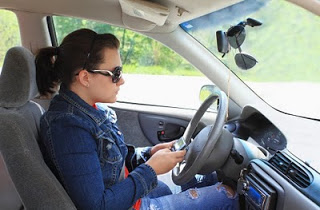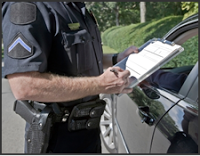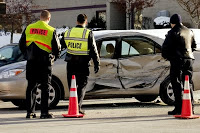Tag Archive: Teen drivers
Behind the Wheel with the Tire Rack Street Survival Class
August 20, 2007
It seems that every state in the country is adopting or introducing new extracurricular driver’s education classes for teens. The death toll for teenage drivers is rather high across the country so classes such as the Tire Rack Street Survival are created to address the issue. Do these classes work or are they just another way for some company to make some money? How effective are these classes really?
While many classes like the Tire Rack Street Survival definitely educate young drivers, it is only through constant parental involvement that significant strides can be made in reducing the teenage driver death toll. Of course, these classes may work if more parents made their teens take them! Without the requirement of mandatory classes, not many teens are going to say, on their own, “oh I cannot drive as well as I should, maybe I should take a driver’s education safety class.” The only way that these classes will make a huge impact on dropping the teenage death tool is mandatory extracurricular driving classes like the Tire Rack Street Survival.
The Tire Rack class does more than just get parents a discount on their liability insurance. This class also teaches by example – behind the wheel of a car as well as the classroom. The material that is covered is real hands-on and you get to experience real world driving situations behind the wheel of your own car. It’s a great way to prepare teenagers about accidents and how to easily avoid them. Plus there is no need to adapt to a strange car either. Other advanced driving schools use simulated demonstrations or even a company car equipped to produce certain driving situations.
This class shows teenage drivers in real world time the consequences of their actions behind the wheel. They learn that every action, no matter how small, creates another action and so forth. So teens learn that split second they took to turn on the radio could be all that stands between them and a tombstone. These lessons that are learned should be ones that every teenager with a driver’s permit should have to receive. Unfortunately, this is not the case at all. Therein lies the problem.
In too many states, driver’s education has to be taken as an extra-curricular activity. So many times, teens do not even take a class and instead just study for and pass the written portion of the exam. Sure, their driving is evaluated but it is usually in a controlled setting. However, if mandatory classes were modeled after the Tire Rack Street Survival course or others, the overall fate of teenage drivers would be more optimistic.

Coming Soon, Texting your Way to a Fine
July 24, 2007
Quite a few states have jumped on the bandwagon about banning driving while talking on the cell phone. However, the growing trend of texting while driving has caused lawmakers, especially in New York to go back to the drawing board to include texting in that ban. And after the recent fatal accident where five teens were killed, with texting as a likely culprit, the heat is really on to get the new ruling passed.
The question remains, “Will a ban on texting really help prevent accidents?” No one really knows for sure and as a result, the proposed law change is getting some mixed reviews. Some people feel that the wireless industry is not doing enough to advertise the dangers of cell phone use while driving. However, others feel that it all boils down to practicing basic defensive driving skills.
People hear that talking on the cell phone and texting has caused accidents and killed people, yet they do not hinder their own actions. Why is that? It’s just like smoking. You know that it is hazardous to your health, yet you do it anyway. The same principle applies with cell phones. Are our lives so busy and competitive that we cannot miss a single moment with our cell phones? How did we ever get along twenty or thirty years ago?
Another part of the problem is how to keep the teenagers from texting while driving. Many of them admit to doing it and know it is dangerous and still do it anyway. At some point, we have to accept responsibility for ourselves. In the case of teenagers who are still feeling their way around the whole driving thing, the parents are going to have to be the guiding force in appropriate driving behavior in teens. Of course, that means that they will have to clean up their own acts so that they can lead by example.
It is because people know better yet do it anyway that is precipitating this texting inclusion in the existing cell phone law. Sometimes, we have to help those who refuse to help themselves. And if it takes imposing fines to get the point across, so be it. The problem is that no one truly knows how much of an impact this law will make on saving lives. We’ll just have to wait and see.

Project Note Home in Wyoming Should Keep Teens on the Straight and Narrow
June 7, 2007
The state of Wyoming has implemented a great new plan called “Project Note Home.” It seems that new teenage drivers tend to not share the fact that they receive traffic tickets with their parents. Shocking, isn’t it? In fact, parents are pretty much clueless until the next insurance bill comes along. However, with “Project Note Home,” any traffic infraction gets communicated to the parents.
Keeping parents in the loop about their teen’s driving record is a smart move for the state. Too often, teens have found out ways to pay for their tickets without their parents finding out about it. These teens are not being held accountable for their actions. What are a few bucks in fines compared to having their driving privileges suspended? Well, with this new program, copies of the traffic violation are being sent home to the parents. Teenagers will now have no way to hide their driving violations.
No longer will parents be shocked to find their teen’s auto insurance bill going up several hundred dollars. Now, they will know exactly why – their teenagers are not practicing safe driving practices. You can bet that a lot more teenagers will experience suspended driving privileges as a result of “Project Note Home.”
There is a side benefit to this new program as well. It could very well save the lives of many teenager drivers. It’s a proven fact that the biggest death toll in car accidents every year fall within the fifteen to twenty year old range. Teenagers are inexperienced. They have not come across every driving situation experience yet. With that inexperience come potential problems.
By being held accountable for every infraction while behind the wheel of a car, teenagers will soon learn to shape up their habits. Speeding is one of the biggest violations on the road along with not wearing a seat belt. Both of these infractions can kill. By alerting parents to the fact that their teenagers are not engaging in safe driving behaviors, this will open a dialogue between the parent and the teen. They will be forced to talk about the situation and perhaps, a lesson or two will be learned.

Winnebago School Board Says Driver’s Ed Is A Privilege, Not A Right
April 5, 2007
Drawing on a tactic long used by parents to influence their teenager’s actions, schools are now dangling the car keys in front of students as a motivator. The Winnebago school board in Illinois has decided to place a bit of extra responsibility on its sophomore students, letting their grades decide if they are eligible to take a school sponsored driver education program.
Following in the footsteps of other regulations within the district applying to sports and other activities, students must now maintain a 2.0 grade point average in order to participate in the school’s driver education program. Placement in these classes is highly sought after, as they cost half of what instruction at a private driver’s education course would.
This restriction adds to the ever-growing list of laws and regulations regarding teenage drivers, frustrating students a bit. However, the additional monitoring and responsibility will only lower the risks related to the youngest of drivers.
Some of the other laws, besides the new grade requirements, include:
- Cell phones may not be used while driving.
- Drivers may not have more than one unrelated passenger under the age of 20 in their vehicle within the first 6 months of being licensed.
- Teen drivers must be off the roads before 11 pm on weekdays and midnight on weekends.
All of these regulations have been put in place to reduce the accident rate among teenage drivers. Insurance Institute for Highway Safety studies show that the accident rate per mile for drivers under twenty years old is four times that of an experienced driver. The youngest of these drivers, at sixteen years old, are involved in twice the number of accidents as the eighteen and nineteen year old drivers.
The Winnebago school district has already passed this plan within their own district, however it is not finalized for next fall as of yet. Since the Illinois State Board of Education rules are more relaxed, they must apply for a waiver to tougher their own school’s restrictions. Once this waiver is approved, the plan will start in the school year immediately following.
Create your own customized Teen Driving Contract online based on the core principles of the Driver Education Handbook for Parents and Florida’s Graduated Licensing laws.

Teens Sharpen Driving Skills Using Collision Avoidance Training
February 26, 2007
Teens learn to drive by experience. However, many of the things that happen behind the wheel cannot be prepared for under normal circumstances. Reactions to blown tires, icy roads, and collisions are a few of the things that teen drivers do not know how control. Enter CAT Training.
CAT Training, otherwise known as Collision Avoidance Training, is offered many places nationwide. No place is it more needed, however, than at a local sports complex in D’Iberville, Mississippi. In this state, teens are allowed to be licensed at age 15, and without passing a driver’s education course no less. With the deaths of 26 young people in recent years, the time felt right to bring in such a program as CAT Training.
Here, in Harrison County, CAT training was given a trial run, and will soon be offered to the public for a nominal fee. The testing group included four school resource officers who will become the course teachers. Students selected by the officers also tested the course, which is said to provide experience that normally takes five to seven years of driving experience to gain.
This program is the first of its’ kind in Mississippi, and was made possible by the Partners for Highway Safety Foundation. After their son died at age 17 in an auto vehicle crash on Mother’s Day weekend 1992, Paul and Ann Burris created the Partners for Highway Safety Foundation in an effort to educate teen drivers of the dangers of risky driving.
National studies show that more than 70% of crashes that involve teen drivers or passengers are avoidable. Inexperience is listed as a factor more important than the abuse of drugs or alcohol in this statistic.
Future dates that the course will be held, as well as costs to attend, have not yet been determined. However, students interested can contact Harrison County officials for information, and they will be notified as soon as the course is open to the general public.
